| |
|
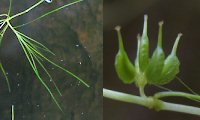 | |
| MaltaWildPlants.com by Stephen Mifsud |

|
| |
|
|
 |  |  |  |
| External Links: |
|
Narcissus tazetta subsp. tazetta (French Daffodil) |
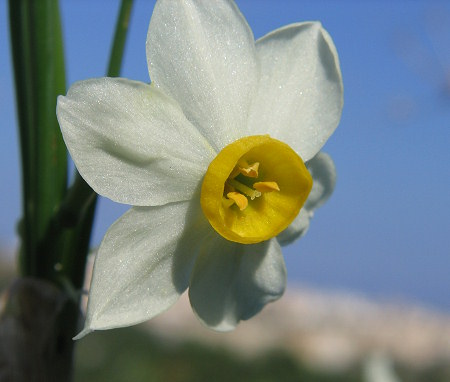
Narcissus tazetta subsp. tazetta (AMARYLLIDACEAE.)
Images for this profile are taken from the Maltese Islands after year 2000. |
|
| Nomenclature |
Species name : | Narcissus tazetta subsp. tazetta L. | Authority : | Carl von Linne, Sweden, (1707 - 1778) | Synonyms :
(basionym or principal syn.) |
|
Plant Family : | Amaryllidaceae Jaume St.-Hil
(Daffodil or Amaryllis Family) | English name(s) : | French Daffodil, Cream Narcissus, Polyanthus Narcissus | Maltese name(s) : | Narċis, Ranċis | Status for Malta : | Indigenous. Present on the Maltese islands before man | Name Derivation : |
Narcissus: To numb, stun or paralyze, referring to the narcotic properties of several plants in this genus. In Greek mythology Narcissus was an attractive youth who fell in love with his own image in water and pined away for it until he died and changed into the narcissus flower. (Greek origin ); 2 = To numb, stun or paralyze, referring to the narcotic properties of the plant. (Greek); In Greek mythology Narcissus was an attractive youth who fell in love with his own image in water and pined away for it until he died and changed into the narcissus flower. (from Funk and Wagnall).
tazetta subsp. tazetta: 1 = "Little cup" - refering to the golden yellow cup-shaped structure of the flower (Latin).
| Remarks : | |
|
| Morphology and structure |
PLANT STRUCTURE: |
Character | Growth Form | Branching | Surface |
Description | | | |
General
Picture |  | 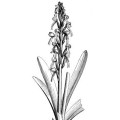 |  |
|
LEAVES: |
Character | Arrangement | Attachment | Venation |
Description | | | |
General
Picture | 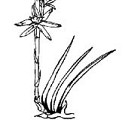 | 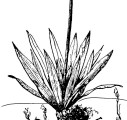 |  |
| |
Character | Leaf Shape | Leaf Margin | Remarks |
Description | | | |
General
Picture |  |  |  |
|
FLOWERS: |
Character | Colour | Basic Flower Type | No. of Petals | No. of Sepals |
Description | White with a golden central crown. | | 6 To be botanically precise, the flower has 3 sepals (outer whorl) and 3 petals (inner whorl) which are identical, and so they are collectively referred to as 6 tepals or perianth segments. | 0 |
General
Picture | | 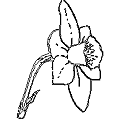 |  |  |
| |
Character | Inflorescence | Description | Ovary | Stamens |
Description | | Sweet scented flower which is made up of 6 white or cream, obtuse petals and a cup-shaped, central corona which is golden yellow and often have a sub-crenated brim. There are 6 stamens arranged in 2 sets of 3, each set being fused with the corolla wall at different levels. There is a tiny central style with 3 swollen stigma. | | |
General
Picture | 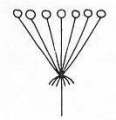 |  |  | 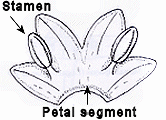 |
| |
Character | Scent | Average Flower Size | Pollen Colour | Other Notes |
Description | YES Strong sweet fragrance which makes the flower popular for. | 25-35mm | Yellow | - |
|
SEEDS: |
Character | No. Per Fruit | Shape | Size | Colour |
Description | 15-40 | Sub-spherical Nearly spherical with minute angled edges. | 3-4 mm | Black |
General
Picture |  |  |  |  |
|
FRUIT AND OTHER BOTANICAL DATA: |
Character | Fruit Type | Colour of Fruit | Subterranean Parts | Other Notes |
Description | | Green Turns to straw colour when ripe. | | - |
General
Picture | 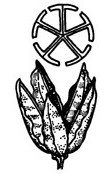 |  |  |  |
|
|
| Plant description and characters | |
Life Cycle: | Perennial. |
Growth Form: | GEOPHYTE (bearing underground bulbs, rhizomes, stolons, etc.) |
Habitat: | Garigue (especially if with considerable amount of soil) uncultivated fields and valleys. |
Frequency: | Frequent |
Localities in Malta: | Rather Common. Can be found in most valleys and sheltered or damp garigue as at Mistra, Wied Encita, Mellieha, Siggiewi (Lapsi), Wardija, Qrendi and most of Gozo. |
Plant Height: | 25-75cm. |
| Oct-Mar |
Protection in Malta: | Protected by law: Schedule VIII of [S.L. 549.44] (Exploitation subject to management measures) |
Red List 1989: | Not listed in the Red Data Book of the Maltese Islands |
Poison: | |
The monocot plant grows from underground bulbs, normally having the size of an egg or slightly larger. After the first rains the bulbs start forming its bluish-green leaves. The leaves are strap shaped (lorate) with an entire margin, blunt tip, erect and sometimes twisted around their longitudinal axis. They are glabrous, flat or sometimes grooved, show faint parallel venation and grow between 15-50cm long and between 3-15mm wide. The plant forms between 4-8 leaves normally growing in a V-shape.
An interesting characteristic is a white sheath with longitudinal green veins around the base of the leaves just at soil level. It can reach a height of 2cm.
From the middle of the leaves grows a tall flowering stalk (also called as scape) which carries 3-12 flowers. They open quickly forming a beautiful inflorescence of many blossoms that can be seen in Malta as early as November. The inflorescence can be regarded as an umbel because the cluster of flowers arise from a common point at the apex of the scape. This locus is wrapped by a protecting, dry, thin membranous sheath called the spathe.
The flowers have pedicels (stalklets) of unequal length between 1cm to 5cm. The inferior ovary is connected to the drooping end of the pedicels, followed by a light green tube about 1.5cm long and finally the perianth itself.
The perianth have 6 petals which are white or sometimes described as cream. More precisely the petals should be referred to as tepals or perianth segments because these are actually 3 sepals and 3 petals of similar shape, colour and size and so all look alike as 'petals'. The sepals tend to have a more pointed tip and are located under the petals. Further more there is another row or 6, central, golden-yellow flaps which are fused as a single circular cup-shaped structure and called the corona. This is between 4-5mm deep and often have a sub-crenated rim. It occupies about one third of the flower diameter.
Inside the corona are located the reproductive organs. There are 6 stamens adhered to the inner wall of the corona and a central tiny style with a 3-lobed stigma. The style is 20-25mm long and connected to the inferior ovary. The stamens are grouped into 2 sets of 3 each each. One set is found inserted at the upper part of the corona wall, and the other at a lower level and alternating radially with the one above.
After fertilisation an ovoid fruit capsule is formed. This is initially green and becomes straw coloured when ripe. The capsule splits into 3 parts longitudinally and so the black seeds inside could escape out. There is not any specialized seed dispersion mechanism; as this is simply achieved by the swaying of the scape with wind which causes the seeds to drop in a nearby area. The seeds are shiny, measures about 3-4mm and have an irregular sub-spherical shape with rounded edges.
|
|
| Information, uses and other details |
Nativity and distribution
The distributional range of this plant is shown in the list below: [WWW-26]
Northern Africa: Algeria; Egypt; Libya; Morocco
Western Asia: Iran; Iraq; Israel; Jordan; Lebanon; Syria; Turkey
Caucasus: Russian Federation - Ciscaucasia; Siberia
Asia: China - Fujian, Zhejiang
Europe: Cyprus; Russian Federation; Albania; Greece (incl. Crete); Italy (incl. Sardinia, Sicily); Yugoslavia; France (incl. Corsica); Portugal; Spain (incl. Baleares).
According to [WWW-77] the origin of this plant is the Mediterranean basin. [WWW-152] states that Narrcissus is a genus of bulbous plants natives of central Europe and the Mediterranean region; one species - N. tazetta - extends through Asia to Japan.
General Notes about Narcissus
Narcissus is the Latin name for a group of hardy, mostly spring-flowering, bulbs. There are several Narcissus species that bloom in the autumn. Daffodil is the common English name for all narcissus. The botanic name of the genus is Narcissus. They are mostly native to the Mediterranean region, but a few species are found through central Asia to China. The range of forms in cultivation has been heavily modified and extended, with new variations available in nurseries practically every year. The name is derived from that of the narcisstic youth of Greek mythology called Narkissos. [WWW-60]
This is the name of the classical youth who met with his death through vainly trying to embrace his image reflected in a clear stream, but from the Greek word narkao (to benumb), on account of the narcotic properties which the plant possesses. Pliny describes it as Narce narcissum dictum, non a fabuloso puero, 'named Narcissus from Narce, not from the fabulous boy.' [WWW-03]
Narcissus are sometimes called jonquils in North America, but strictly speaking that name belongs only to the rush-leaved Narcissus jonquilla and cultivars derived from it. Though "Narcissi" is given in dictionaries as the plural of "Narcissus", The American Daffodil Society prefers the use of "narcissus" for both singular and plural. [WWW-60]
Narcissus tazetta is considered the oldest cultivated narcissus, as it was known in ancient Egypt and Greece. The Cream Narcissus (N. tazetta) can be found growing in meadows, grassy and cultivated fields and garrigue, especially in damp places. [WWW-151]
The popular English names Daffodowndilly, Daffodily Affodily, are a corruption of Asphodel, with which blossoms of the ancient Greeks this was supposed to be identical. It is in France the fleur d'asphod�le, also 'pauvres filles de Sainte Claire.' [WWW-03]
Narcissus and Greek Mythology
NARCISSUS, in Greek mythology, son of the river god Cephissus and the nymph Leiriope, distinguished for his beauty. The seer Teiresias told his mother that he would have a long life, provided he never looked upon his own features. His rejection of the love of the nymph Echo (q.v.) drew upon him the vengeance of the gods. Having fallen in love with his own reflection in the waters of a spring, he pined away (or killed himself) and the flower that bears his name sprang up on the spot where he died. According to Pausanias, Narcissus, to console himself for the death of a favorite twin-sister, his exact counterpart, sat gazing into the spring to recall her features by his own. [WWW-152]
Narcissus, representing the early spring-flower, which for a brief space beholds itself mirrored in the water ?nd then fades, is one of the many youths whose premature death is recorded in Greek mythology (cf. Adonis, Linus, Hyacinthus); the flower itself was regarded as a symbol of such death. It was the last flower gathered by Persephone before she was carried off by Hades, and was sacred to Demeter and Core (the cult name of Persephone), the great goddesses of the underworld. From its associations Wieseler takes Narcissus himself to be a spirit of the underworld, of death and rest. It is possible that the story may have originated in the superstition (alluded to by Arte-mfdorus, Oneirocritica, ii. 7) that it was an omen of death to dream of seeing one's reflection in water. [WWW-152]
Horticultural divisions of Narcissus
The following is a list of Horticultural divisions of Narcissus given by reference [WWW-60] and established by the Royal Horticultural Society in England [WWW-150].
- 1. Trumpet daffodils
- 2. Large-cupped daffodils
- 3. Small-cupped daffodils
- 4. Double daffodils
- 5. Triandrus daffodils
- 6. Cyclamineus daffodils
- 7. Jonquilla daffodils
- 8. Tazetta (Poetaz or Bunch-flowered) daffodils
- 9. Poeticus (Poet's) daffodils
- 10. Bulbocodium daffodils
- 11. Split-corona daffodils
- 12. Other daffodils which don't fit the above divisions
- 13. Species and wild hybrids
Miniature daffodils are found in all divisions.
According to reference [WWW-151], there are five weli-marked sections.
1. The hoop-petticoat narcissi, sometimes separated as the genus Corbularia, are not more than from 3 to 6 in. in height, and have grassy foliage and yellow or white flowers.[WWW-151] (Read more...)
2. A second group is that of the Pseudonarcissi, constituting the genus Ajax of some botanists, of which the daffodil, N. Pseudo-narcissus is the main type. [WWW-151] (Read more...)
3. Another group, the mock narcissi or star daffodils, with coronets of medium size, includes the fine and numerous varieties of N. incomparabilis, one of which, with large, double flowers, is known as butter-and-eggs; N. odorus, known as the campernelle jonquil, has two to four uniform bright yellow flowers, and is considered a hybrid between N. Jon guilla and N. Pseudonarcissus.[WWW-151] (Read more...)
4. The polyanthus or bunch narcissi form another well-marked group, whose peculiarity of producing many flowers on the stem is indicated by the name. In these the corona is small and shallow as compared with the perianth. Some of the hardier forms, as N. Tazetta itself, the type of the group, succeed in the open borders in light well-drained soil, but the bulbs should be deeply planted, not less than 6 or 8 inches. [WWW-151] (Read more...)
5. There remains another little group, the poets or pheasantseye narcissi (N. poelicus), in which the perianth is large, spreading and conspicuous, and the corona very small and shallow. [WWW-151] (Read more...)
Chemical composition
The following table shows the list of chemicals that has been extracted from the plant. The table also gives which part of the plant the chemical is found and at what concentration (low and high) it was found. This list was taken from [WWW-66]
| Chemical |
Part |
Lo
ppm |
Hi
ppm |
| 3-O-MARITIDINE |
Plant |
|
|
| 6ALPHA-HYDROXY-3-O-METHYL-EPIMARITIDINE |
Plant |
|
|
| 6BETA-HYDROXY-3-O-METHYL-EPIMARITIDINE |
Plant |
|
|
| ALKALOIDS |
Leaf |
|
2300 |
| ALPHA-PHENYLPROPYL-ACETATE |
Flower |
35 |
75 |
| ALPHA-PHENYLPROPYL-ALCOHOL |
Flower |
70 |
150 |
| ALPHA-TERPINEOL |
Flower |
90 |
190 |
| BENZALDEHYDE |
Flower |
|
|
| BENZOIC-ACID |
Flower |
|
|
| BENZYL-ACETATE |
Flower |
520 |
1115 |
| BENZYL-ALCOHOL |
Flower |
165 |
360 |
| CINEOLE |
Flower |
80 |
175 |
| CINNAMYL-ALCOHOL |
Flower |
|
|
| DEMETHYLHOMOLYCORINE |
Bulb |
|
|
| EO |
Flower |
2100 |
4500 |
| EPIGALANTHAMINE |
Plant |
|
|
| EUGENOL |
Flower |
|
|
| FIANCINE |
Plant |
|
|
| GALANTHAMINE |
Plant |
|
|
| GALANTHINE |
Plant |
|
|
| HAEMANTHAMINE |
Plant |
|
|
| HEPTYL-ALCOHOL |
Flower |
5 |
10 |
| HIPPEASTRINE |
Plant |
|
|
| HOMOLYCORINE |
Plant |
|
|
| INDOL |
Flower |
30 |
65 |
| ISORHAMNETIN |
Flower |
|
|
| LINALOL |
Flower |
525 |
1125 |
| LYCORAMINE |
Bulb |
|
|
| LYCORANOLIDINE |
Bulb |
|
|
| LYCORANOLINE |
Bulb |
|
|
| LYCORENINE |
Bulb |
|
|
| LYCORINE |
Stem |
|
|
| MARITIDINE |
Plant |
|
|
| MARITIDINE-O-LYCORAMINE |
Plant |
|
|
| NARCICLASINE |
Bulb |
|
66 |
| NARCISSIDINE |
Plant |
|
|
| NARCISSIN |
Flower |
|
|
| NARCITINE |
Plant |
|
|
| NARTAZINE |
Plant |
|
|
| NARZETTINE |
Plant |
|
|
| NONANAL |
Flower |
|
1 |
| O-METHYLMARITIDINE |
Plant |
|
|
| PANCRATINE |
Plant |
|
|
| PHENYL-ETHYL-ALCOHOL |
Flower |
2 |
5 |
| PHENYLETHYL-ACETATE |
Flower |
10 |
20 |
| PLUVIINE |
Bulb |
|
|
| PRETAZETTINE |
Stem |
|
|
| PSEUDOLYCORINE |
Stem |
|
|
| SUISEMINE |
Plant |
|
|
| TAZETTINE |
Plant |
|
|
| UNDECALACTONE |
Plant |
|
|
Lycorine has been found as one of the major alkaloid from Amaryllidaceae plants. Therefore, its content has been determined by HPLC from some Amaryllidaceae plants as shown further below. For this purpose, HPLC analysis was performed on column packed with C-18 bonded silika gel operated in reversed phase mode, using chloroformmethanol (9:1) as mobile phase. Lycorine was determined at 290 nm using photodiod-array
detector (ref.12). Lycorine amounts determined from the bulbs of these plants were given as
follows:
Galanthus elwesii - 0.011 %
Galanthus ikariae - 0.043 %
Leucojum aestivum - 0.078 %
Narcissus tazetta ssp. tazetta - 0.089 %
From the air-dried and powdered bulbs, the alkaloids were extracted by routine acid-base workup
procedure. Isolation and purification studies have afforded (-)-lycorine (ref.5) along with six
other major Amaryllidaceae alkaloids obtained for the first time from these plants.
The alkaloids that have been isolated from bulbs of Narcissus tazetta ssp. tazetta obtained from results by spectral data are [373] :
(-)-buphanisine,
(+)-9-o-demethylhomolycorine,
(+)-haemantamine,
(-)-galanthamine,
(+)-3-epihydroxybulbispermine
(+)-tazettine
Extracts from Narcissus bulbs is not something recent, but it goes back to the 19th century. Below is a list of chemicals and compounds that have been extracted from Narcissus long time ago according to rference [WWW-18] which was published in 1898.
-
M. Jourdan has described a white, deliquescent, active principle, possessing emetic properties, which he named "narcitine,"
-
M. Caventou obtained from the flowers an odorous, yellow coloring matter, which he termed "narcissine."
-
From the bulbs, Mr. A. W. Gerrard obtained a small amount of a neutral crystalline body, and a non-crystalline alkaloid, somewhat analogous to atropine, to which the name pseudo-narcissine has been given.
-
The flowers of the Narcissus yielded Robiquet, by extraction with ether, a volatile, butyraceous, yellow oil, very fragrant, from which jonquil camphor crystallized out, upon cooling, in the form of yellowish, warty crystals, volatile by heat.
-
Louis Robechek found the bulbs of Narcissus orientalis (Chinese lily) to contain 0.02% of an alkaloid, and 0.2% of a glucosid; furthermore, resin, pectin, sugar (3%), mucilage (9.5%), ash (3%).
An alkaloid was first isolated from the bulbs of N. pseudo-narcissus by Gerard in 1578, and obtained in a pure state as Narcissine by Guérin in 1910. The resting bulbs contain about 0.2% and the flowering bulbs about 0.1%. With cats, Narcissine causes nausea and purgation. [WWW-03]
History and Traditional uses in Medicine
The flowers and bulbs of this plant are the parts that have been employed, and the recent, wild plant appears to possess more active properties than the cultivated. Internally, in large doses, it is an active and even dangerous article, occasioning severe emeto-catharsis and gastro-intestinal inflammations, and its local application to the surface of ulcers and wounds is stated to occasion similar results, and, in addition thereto, serious depressing effects upon the nerve centers. The alkaloid from the bulb is a mydriatic, and, in many respects, resembles atropine in action. [WWW-18]
As a medicine, narcissus is rarely employed in this country, but is said to possess emetic, cathartic, antispasmodic, and narcotic properties. It has been used in epilepsy, in hysteria, and other spasmodic affections. Laennec employed it with success in pertussis, and other European practitioners have accorded to it an efficient action in intermittent fever, diarrhoea, dysentery, worms, etc. It has likewise been found of prompt benefit in severe catarrh. The cases for narcissus are those exhibiting epileptoid movements of the muscles, in chorea, in rheumatism, showing muscular contractions, and in cerebral diseases, with dull eyes and dilated pupils. A tincture of the bulbs by maceration in 98% alcohol, may be given in doses of 1/4 drop to 10 drops. Dose of dried flowers or bulbs, in powder, from 10 to 60 grains; from 1 to 3 grains of the aqueous extract provokes vomiting. A syrup, ethereal oil, and acetous tincture have also been employed.
[WWW-18]
Socrates called this plant the 'Chaplet of the infernal Gods,' because of its narcotic effects. An extract of the bulbs, when applied to open wounds, has produced staggering, numbness of the whole nervous system and paralysis of the heart. [WWW-03]
Herrick alludes in his Hesperides to the Daffodil as a portent of death, probably connecting the flower with the asphodel, and the habit of the ancient Greeks of planting that flower near tombs. [WWW-03]
The bulbs of the Daffodil, as well as every other part of the plant are powerfully emetic, and the flowers are considered slightly poisonous, and have been known to have produced dangerous effects upon children who have swallowed portions of them. [WWW-03]
The influence of Daffodil on the nervous system has led to giving its flowers and its bulb for hysterical affections and even epilepsy, with benefit. [WWW-03]
A decoction of the dried flowers acts as an emetic, and has been considered useful for relieving the congestive bronchial catarrh of children, and also useful for epidemic dysentery. [WWW-03]
In France, Narcissus flowers have been used as an antispasmodic. [WWW-03]
A spirit has been distilled from the bulb, used as an embrocation and also given as a medicine and a yellow volatile oil, of disagreeable odour and a brown colouring matter has been extracted from the flowers, the pigment being Quercetin, also present in the outer scales of the Onion. [WWW-03]
The Arabians commended the oil to be applied for curing baldness and as an aphrodisiac. [WWW-03]
Medicinal Uses
The plant has the following medicinal properties according to reference: [WWW-66] .
| Abscess |
Uses to treat abscesses which are a localised collection of pus caused by suppuration buried in tissues, organs or confined spaces. Usually due to an infective process. [WWW-32] |
| Analgesic |
A medicine used in to relieve pain. [WWW-32] |
| Antiphlogistic |
Substances which reduces or counteracts inflammation [WWW-32] |
| Anti-cancer |
Used in the treatment of cancer; "anticancer drug"; "an antineoplastic effect". [WWW-32] |
| Demulcent |
A medication (in the form of an oil or salve etc.) that soothes inflamed or injured skin. [WWW-32] |
| Diuretic |
Tending to increase the secretion and discharge of urine. [WWW-32] |
| Emetic |
An agent that causes vomiting, so as the stomach is emptied from its contents. [WWW-57] |
| Gynecopathy |
Referring to treatment or use as a drug in any of the various diseases specific to women [WWW-06] |
| Mastitis |
(Treatment for the) Inflammation of the mammary gland or breast. [WWW-57] |
| Poultice |
A soft composition, as of bread, bran, or a mucilaginous substance, to be applied to sores, inflamed parts of the body, etc. so as to relief them. [WWW-57] |
| Purgative |
A purging medicine; stimulates evacuation of the bowels. [WWW-32] |
| Sclerosis (Uterus) |
(Treatment for) A induration or hardening, especially hardening of a part from inflammation and in diseases of the interstitial substance. The term is used chiefly for such a hardening of the nervous system due to hyperplasia of the connective tissue or to designate hardening of the blood vessels. [WWW-57] |
| Tumor |
Used to treat tumors which are an abnormal mass of tissue that results from excessive cell division that is uncontrolled and progressive, also called a neoplasm. Tumours perform no useful body function. They may be either benign (not cancerous) or malignant.
[WWW-57] |
Used in the treatment of boils and mastitis[174]. The root is emetic[240]. It is used to relieve headaches[240]. The chopped root is applied externally as an antiphlogistic and analgesic poultice to abscesses, boils and other skin complaints[218]. The plant has a folklore of effectiveness against certain forms of cancer. This might be due to benzaldehyde changing to laetrile-like compounds or to lycorine changing to lycobetaine-like compounds in the body [218]. An essential oil obtained from the flowers is used in perfumery[171].
Other Uses
The bulb is used in homoeopathy for the preparation of a tincture. [WWW-03]
From the fragrant flowers of the JONQUIL (N. jonquilla) and the CAMPERNELLA (N. odorus), a sweet-smelling yellow oil is obtained in the south of France, used in perfumery. [WWW-03]
Cultivation Details
Prefers a deep rather stiff soil but succeeds in most soils and situations[1]. Grows well in heavy clay soils. Prefers an alkaline soil with a pH between 7 and 8[200]. Best grown in a warm sunny corner with shelter from cold winds [245].
The dormant bulbs will withstand soil temperatures down to at least -5�c[214]. Cultivated for its essential oil[171]. The flowers are very powerfully scented[245]. [WWW-151] Describes the scent as intoxicatingly fragrant. The sub-species N. tazetta chinensis. Roemer. is used in Japanese medicine [174].
The ease with which most species of Narcissus can be grown in this country is remarkable, since, being mostly natives of Southern Europe and Northern Africa, they have to adapt themselves to very different conditions of soil and climate. [WWW-03]
Propagation Details
The most common propagation methods are from seeds and division of bulbs.
Seed:
Best sown as soon as it is ripe in a cold frame. A short stratification will improve the germination of stored seed. Sow the seed thinly so that the seedlings can be left undisturbed in the pot for their first two years of growth. Give them an occasional liquid feed in the growing season to ensure they do not become nutrient deficient. When the plants become dormant in the summer, pot up the small bulbs placing 2 - 3 bulbs in each pot. Grow them on for another one or two years in the greenhouse before planting them out when they are dormant in late summer. [KF]
Division of bulbs:
This should be practiced after the leaves die down in early summer[1]. Larger bulbs can be replanted immediately into their permanent positions, or can be stored in a cool place and then be planted out in the autumn. It is best to pot up the smaller bulbs and grow them on for a year before planting them out when dormant in the autumn. [KF]
When they are lifted, the old bulbs (mostly ones that have been planted for 2 or 3 years), which are surrounded by offsets or small bulbs, can be separated at the base. These offsets will become flowering bulbs within one or two seasons, according to their size. They should be taken off as soon as the leaves have died down, and may be replanted at once or stored until fall. Raising Narcissi by seeds is done only for the purpose of acquiring new varieties or species, as the seedlings will not be ready to bloom for 5 or more years. The seeds should be sown as soon as they are ripe in late summer or early fall, in a cold frame. They should be set about one inch apart. The seedlings may then be left undisturbed until the leaves have died down the following July. In September the small bulbs should be set in a bed of sandy soil made up in a frame, or in a prepared border out of doors. [WWW-43]
Use the top of your refrigerator to store bulbs as it is heat that is required to keep the bulb healthy. When you are ready to plant, fill a container of choice with one half to three-quarters of coarse potting soil (mix in sharp builders sand or perlite or bark). Place bulbs side by side then fill around the bulbs with pebbles to hold them in place. Instead of pebbles, try a scattering of rye grass seed around the bulbs for a more natural base. [WWW-150]
Water the bulbs well after planting. Wait until the top of the soil surface feels dry to water again. Provide bright daylight or supplement lighting to avoid weak stems. Once the bulbs sprout, water when the soil surface feels dry which may be 2-3 times a week - not too much, not too little. There is no need to use fertilizer. [WWW-150]
Garden cultivation and potting
These plants can live in regular well-tilled garden soil, although, they grow best in well-drained loamy ground. The flowers are not so long-lived on light land as of those that are grown on loamy soil. On ground containing a lot of clay, sand should be mixed in freely along with compost or other organic matter. [WWW-03]
It is not a good idea to add fresh manure to ground on which Narcissi are to be planted. On poor, light ground, however, well-decayed manure is beneficial. It should be dug in to a depth of 9-12 inches. The best fertilizer for Narcissi is bone meal. This should be spread on the soil at the rate of 2 ounces per square yard and forked in before the bulbs are planted. September through early October is the best time to plant the bulbs in the garden. If you're growing them for exhibition, they should be planted as soon as the leaves have died down in July and August. [WWW-03]
Their size determines the depth at which they should be planted. Large bulbs should be covered no less than 4-5 inches, medium sizes should have a covering of 3-4 inches and smaller ones with 2-3 inches. One of the most common mistakes is to plant them too close to the surface. Narcissi can be left undisturbed for many years until they become so crowded that they fail to bloom abundantly. Usually, though, they need to be lifted at the end of 3 or 4 years. When they are planted in grass or woodland, they should be set further apart so that they can be left undisturbed for a longer period of time. The best flowers are obtained by lifting and replanting them annually, or in alternate years, as soon as the leaves have died down. [WWW-03]
The Narcissus is one of the easiest to grow in pots in the greenhouse, conservatory and house in the winter and early spring. By potting them at intervals of a few weeks, from August until the end of September, it's possible to have blooming plants from December until the middle of March. The best compost to use is loam (old turf) with a little leaf mold, decayed manure and a good sprinkling of sand added. They will do much better in this mixture than in regular garden soil. If loam isn't available, good garden soil will do with the leaf mold, decayed manure and sand added (unless the soil is already light). [WWW-03]
The bulbs should be set so that the most part of each one is covered with soil; the smaller bulbs may be wholly buried. The number of bulbs to a pot depends on their size; four moderately sized bulbs or three large ones can fit in a 6-inch pot. When potting is finished, the pots should be placed outside on a bed of cinders or a hard base and thoroughly watered, making sure that the soil is moistened all the way through. They are covered with old sifted ashes, sand or peat moss to a depth of 6-7 inches. It is important to use old ashes that have been exposed to air for some time; if fresh ashes from the fire are used, the bulbs will most likely be seriously damaged. No further watering is necessary. [WWW-03]
After six weeks the bulbs should be checked. Most of them will have become well rooted and top growth of the earliest varieties will have started. The pots with the bulbs that have begun to grow should be placed in a cold frame or in a greenhouse where the bulbs may grow under cool conditions yet not be subjected to frost. It's necessary to shade them for a few days; if this isn't done, the sudden change from darkness to full light may cause the tips of the leaves to turn yellow. By placing the pots, a few at a time, in a higher temperature, a succession of flowers will be assured. A temperature of 50 degrees F is high enough at first, but this may be increased to 55 or even 60 degrees when the flower buds begin to show if flowers are desired quickly. [WWW-03]
In early summer, the bulbs that have been forced may be planted in the garden, in a place where they are unlikely to be disturbed. They will recover, become established and bloom in future years. When Narcissi are forced into early bloom to provide cut flowers, it's usual to grow them in flats. The bulbs are planted almost touching each other, in flats that are about 4 inches deep. The type of soil needed, time of planting and aftercare of the flats are the same as for Narcissi in pots. [WWW-03]
In homes, Narcissi are sometimes grown in other types of containers and in media other than soil. Varieties of the Tazetta section particularly, especially the varieties Paper White, Soleil d'Or and orientalis (Chinese Sacred Lily), are often cultivated in undrained containers in water and pebbles, or in bulb fiber or vermiculite. The practice of planting groups of bulbs in grassy plains ensures pleasant results. They look great among trees and shrubs, on grass banks, on the edges of lawns, in the orchard and in odd corners that are often neglected and allowed to run wild. The best time to plant the bulbs is in early fall, when the ground is fairly moist. It's useless to try planting while the ground is hard and dry. A special tool made for the easy planting of bulbs in grassland is very helpful and time saving. [WWW-03]
Another method is to cut and roll back the turf, fork over the soil, set the bulbs, and replace the turf. Bulbs which are naturalized (that is, planted outdoors in grassy places and other less formal parts of the garden) shouldn't be planted too close together; there should be 6-8 inches between them; otherwise they will become overcrowded in a few years and cease to bloom freely. They should be covered with about 3 inches of soil. Miniature narcissi that are planted outdoors should be planted in September in well-drained, sandy, loamy soil in sheltered places. Miniatures grown in a greenhouse should be potted in September also, in 5-inch pots. The bulbs should be set about an inch apart and covered with about an inch of soil. The pots should be placed in a cold, shaded frame for six weeks to ensure the development of roots before top growth begins; if they are then placed in a cool greenhouse where night temperatures of 40-50 degrees are maintained, they'll be gorgeous in winter or early spring. [WWW-03]
Attack from other animals and insects.
No genus of flowering plants is more readily cultivated and less liable to disease, and the presence in its leaves and roots of innumerable bundles of needle-shaped crystals of calcium oxalate, termed raphides, protect it from injury of browsing and gnawing animals, rendering the plants indigestible and possibly poisonous to cattle and smaller animals. The Crocus and Lily are not thus equipped for defence against browsing animals. Rabbits often fall prey to it. [WWW-03]
The only insect enemy from which the Narcissus seems to suffer is the fly Merodon equestris, the grub of which lays an egg in or near the bulb, which then forms the food of the larva. This pest causes serious damage in Holland and the south of England. [WWW-03]
Brief Notes about the Toxicity of Narcissus
Reference [WWW-79] states that Narcissus species is toxic to humans in two ways. It causes Dermititis (skin rash or irritation) when contact to skin and also causes minor toxicity with the result of of minor illnesses such as vomiting or diarrhea.
In the list of toxic plants, [WWW-87] states that Daffodil and Narcissus bulbs possess alkaloids (glycoside) which when ingested can casue any of the following symptoms: dizziness, abdominal pain, nausea, vomiting, diarrhea. Large doses can cause trembling, convulsions, and death. [WWW-123] gives similar toxic properties and symptoms if the bulbs are ingested and adds that the toxic principles are Phenanthridine alkaloids such as lycorine, and also calcium oxalate crystals. Contact dermatitis ("lily rash") is caused following handling of bulbs, flowers and stems. This reference states that it is toxic only if large quantities are eaten but skin irritation is severe.
The aerial parts cause dermatitis in sensitive individuals. The bulbs can also cause dermatitis. Humans have been poisoned after ingesting bulbs thought to be onions, as have cattle when they were fed bulbs instead of feed in times of scarcity. Family pets may be at risk if they ingest daffodils. [WWW-186]
Human poisonings have also been associated with dormant bulbs of paper-white narcissus (Narcissus tazetta 'Paper-white') or amaryllis (species of Hippeastrum), which may be eaten by people who mistake them for onions. Given as holiday gifts for forcing in late winter, these bulbs contain low levels of toxic alkaloids. [WWW-149].
A case of poisoning by Daffodil bulbs, cooked by mistake in the place of leeks, was reported from Toulouse in 1923. The symptoms were acute abdominal pains and nausea, which yielded to an emetic. The bulbs of N. poeticus (Linn.), the POET'S NARCISSUS, are more dangerous than those of the Daffodil, being powerfully emetic and irritant. The scent of the flowers is deleterious, if they are present in any quantity in a closed room, producing in some persons headache and even vomiting. [WWW-03]
In-vitro bioassay studies showing the Toxicity of Narcissus tazetta
In reference [374], extracts from 55 medicinal plants found in Turkey where analysed for their toxic properties in various bioassays. For keeping this account brief, only the toxicity for N. tazetta will be accounted for.
In the evaluation for general toxicity using the brine shrimp, N. tazetta caused complete
mortality within 24 hours.
In tests against insects 17 extracts possessed significant insecticidal activity against the milkweed bug and 9 were toxic to mosquitos. However, plant extracts toxic to the milkweed bug revaled three prominent families including Amaryllidaceae (4 species), Liliaceae (4 species) and Umbelliferae (3 species). This suggests that insecticide activity may be an important defensive priority for pharmacologically active plants. Insecticidal activity of N. tazetta extract recorded as 90 % or greater mortality within six days against Milkweed bug.
Nematocidal tests revealed 9 active extracts that gave complete mortality within 24 hours. One can note that there is less overlap with either the insecticidal or brine shrimp lethality tests. Only 3 species possessed complete crossover toxicity with both brine shrimp and insecticidal activity namely, Leucojum aestivum, Narcissus tazetta, and Onobrychis arwna. Thus, differences between organisms and their sensitivity to the extracts is highlighted by the nematocidal tests. There seems to be a high convergence in susceptibilty between insects and brine shrimp that is not shared with nematodes.
Assays for antimicrobial activity yielded 13 extracts with antibacterial activity (24 % of extracts
tested) and oniy 4 ( 7 %) with fungicidal activity. No crossover activity between bacteria and
fungi was found. N. tazetta extracts did not show antimicrobial activity signaled by a zone of inhibition of at least 4 mm against Pseudomonas solanaciarum. Neither the extracts shown antifungal activity
signaled by a zone of inhibition of at least 1 cm2 against Cladosporium cucumerinum.
As a conlusion, the authors identified 8 plant extracts showing broad spectrum activity in three or more bioassays of which Narcissus tazetta is one of them, as it has been written above. [374]
Skin Irritation and Dermititis
Dermatitis from Narcissus is probably always caused partly by an allergic mechanism and partly by irritant effects, the clinical picture depending on the predominance of one or other mechanism and on the mode of exposure. Dogs also are sometimes affected when running amongst the flowers. Nurserymen and pickers have repeatedly noted that some cultivars provoke dermatitis more readily than others. The cultivars Camparelle, Ornatus, Gloriosa, Scilly White, Grande Monarque, Actaea and Princeps have proved particularly troublesome.
[WWW-27]
The allergen is present in the leaf, stem, and petals. It is not present in an ether extract but is present in ethanol, acetone, and water extracts. Flower extracts (such as Narcissus absolute) was found to be slightly irritating to the skin of mice and swine when applied under occlusion for 24 hours. When applied to human skin at a concentration of 2% in petrolatum, it was found to be non irritant following a 48 hour closed-patch test, and was not found to be a sensitiser in 25 human volunteers. [WWW-27]
Narcissus absolute
'Narcissus absolute' is a fragrance raw material prepared from the flowers of various Narcissus species (notably N. poeticus and N. tazetta). Narcissus absolute is prepared by extraction of the flowers with petroleum ether which is evaporated to produce a "concrete", and this is then extracted to produce the "absolute". The absolute contains linalool, benzyl acetate, benzyl alcohol, terpineol, cineol, phenylpropyl and phenylethyl alcohols and their acetates, n-heptanol, n-nonanal, etc. [WWW-27]
Antibacterial activity
Antibacterial activity studies were performed by the agar well diffusion method using Mueller
Hinton Agar medium(16). The ethanolic extracts of Narcissus tazetta ssp. tazetta and Leucojum
� 1999 IUPAC 4
aestivum at 200 mg/100 mL concentrations have shown antibacterial activity against
Staphylococcus aureus, Pseudomonas pseudomolli, Vibrio cholerae, Enterobacter cloacea,
Corynebacterium hoffmanni, C. diphteriae and Salmonella typhi using ampicillin (30 mg/100
mL) and Tobramicin (10 mg/100 mL) as standard antibiotic. [373]
Antifungal activity
Antifungal activity of the ethanolic extracts of these plants was measured by the tube dilution
method (ref.17). A solution of the each extracts in DMSO was added to molten Sabouraud
dextrose Agar (SDA) to prepare slants. The slants were inoculated with the fungi and incubated
at 29°C for seven days. Inhibition of the growth was observed, and MIC values were determined
against a standard antifungal compound (griseofulvin) on the 8 days. Four of the plant extracts
have shown significant activity against Nigrospora oryzae, Microsporum canis, Pleuralus
ostreatus, Curvularia lunata and Trichophyton longifusus. Besides, the extract of Narcissus
tazetta ssp. tazetta has shown significant activity against Drechsleza rostrata, Aspergillus niger,
candida albicans, Pleuralus ostreatus and Alefcheria boydii. [373]
Antiplatelet activity
The antiplatelet effect of these extracts against human platelet aggregation induced by
arachidonic acid, collagen and platelet activated factor have been examined. All plant extracts as
well as lycorine showed complete inhibition on platalet aggregation caused by AA,collagen and
PAF. In addition, the extracts of Narcissus tazetta ssp. tazetta and Leucojum aestivum along
with lycorine showed inhibition on the contraction of rat aorta caused by high potasium and
norepinephrine. This predicts that ethonolic extract of this plant may contain calcium-channel
blocking agents. [373]
Insecticidal activity
Insecticidal activity of the extracts of Galanthus elwesii, Leucojum aestivum and Narcissus
tazetta ssp. tazetta were recorded as 90 % or greater mortality within six days against Milkweed. [373]
Antimalarial activity screening of some alkaloids and the plant extracts from Amaryllidaceae.
Four groups of Amaryllidaceae alkaloids, namely lycorine-, crinine-, tazettine-, and galanthamine-type, as well as plant extracts of the Amaryllidaceae plants (Pancratium maritimum, Leucojum aestivum, and Narcissus tazetta ssp. tazetta) growing in Turkey were evaluated in vitro for their ability to inhibit Plasmodium falciparum growth by a high-throughput screening method with a 96-well microtiter plate. All four groups of alkaloids exhibited antimalarial activity at different potencies. 6-Hydroxyhaemanthamine, haemanthamine and lycorine were found to be the most potent alkaloids against P. falciparum (T9.96) and galanthamine and tazettine had the least potent activity against P. falciparum (K1). [372]
Galanthamine and lycorine exhibit cytotoxic activity in vitro against fibroblastic murine nontumour
cells. It has been noticed that some compound possessing cytotoxic activity will also
possess antimalarial activity. For this purpose, the activity of Amaryllidaceae alkaloids and the
extracts of Amaryllidaceae plants was studied in vitro against a chloroquine resistant (K1) strain
of Plasmodium falciparum. using mefloquine and chloroquine as standard. The IC50 values were
calculated. The extract of Narcissus tazetta ssp. tazetta and Leucojum aestivum, lycorine,
tazettine and galanthamine were found to exhibit antimalarial activity as predicted.
However, galanthamine has less potency than others as well as standards. [373]
Cytotoxic quaternary alkaloids from the flowers of Narcissus tazetta.
Intensive chromatographic separation of the polar fraction of an ethanolic extract of the fresh flowers of Narcissus tazetta L. (Amaryllidaceae) yielded two new quaternary alkaloids with a phenanthrene skeleton, N-methyl-8,9-methylenedioxy-phenantridinium methylsulfate (1) and N-methyl-8,9-methylenedioxy-phenantridinium malate (2). The structure determination of the alkaloids was based on one- and two-dimensional NMR studies including HMQC, and HMBC studies, and mass spectroscopic analysis. The existence, in 1, of the methylsulfate group was confirmed by X-ray diffraction analysis. Cytotoxic activities for 1 and 2 against a panel of cancer cell lines are also reported. [371]
Effects of crude extracts of various plants on infectious bovine rhinotracheitis virus-plaque production.
Extracts of 28 plants were tested without demonstable antiviral activity in an agar-overlay plaque-reduction antiviral assay system, using infectious bovine rhinotracheitis virus and bovine endocardial cell cultures. Ethanolic extract of Narcissus tazetta L bulb elicited antiviral activity by inhibition of viral plaque formation. Antiviral activity was demonstrated against infectious bovine rhinotracheitis and equine rhinopneumonitis viruses. Narcissus tazetta L bulb did not directly inactivate the virus extracellularly. The extract exhibited only limited toxicity to rapidly multiplying bovine endocardial cells at plaque-inhibitory levels and was not cytoxic to preformed confluent cell monolayers. Narcissus extract did not induce the formation of drug-resistant viral strains. [370]
Personal Observations
Over-Picking of flowers
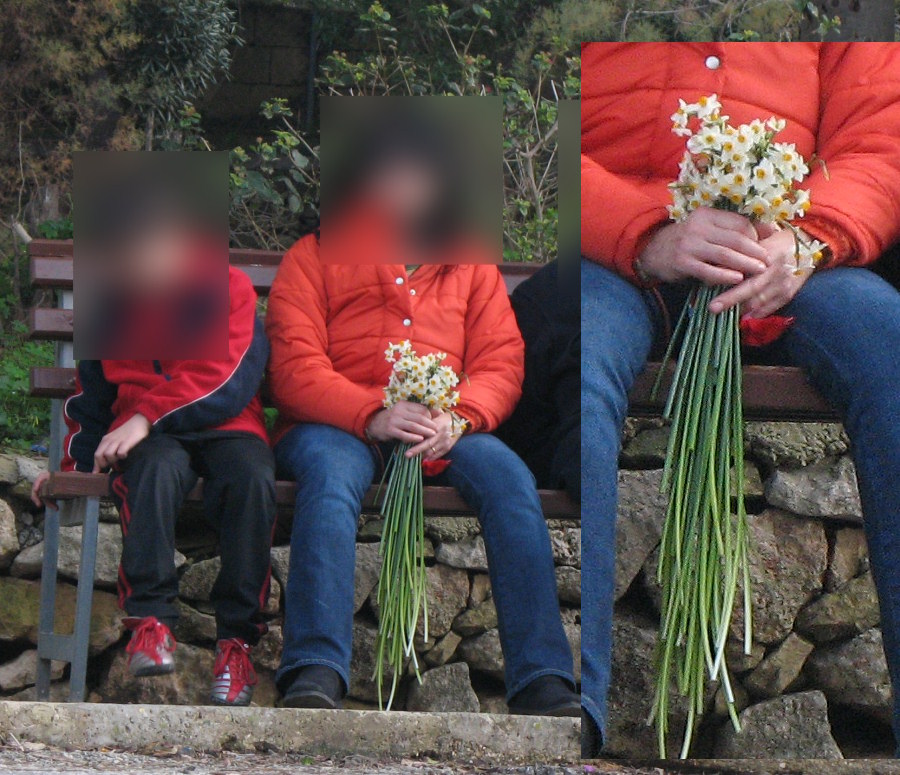 The largest enemy of this plant are Maltese people. For several decades and maybe centuries, people used to cut the flowering stems and use them as bunches to decorate their houses or more often churches, religious communities or graves. When Malta was inhabitated by less than 100,000 people, and garigues where more vast than nowadays, this practice had not much left a negative impact on the population of Narcissus tazetta, but today, Malta nearly holds 400,000 people and the garigue areas are much more restricted than centuries ago. Some years ago, Narcissus tazetta was even cut from the environment and sold as bunches to people. Parents often tell their children to cut as many flowers as they can find rather to educate them and tell them the importance to be left untouched. Cutting one or two flowers is probably fine but a whole bunch like the adjecent photo is untolerable.
The largest enemy of this plant are Maltese people. For several decades and maybe centuries, people used to cut the flowering stems and use them as bunches to decorate their houses or more often churches, religious communities or graves. When Malta was inhabitated by less than 100,000 people, and garigues where more vast than nowadays, this practice had not much left a negative impact on the population of Narcissus tazetta, but today, Malta nearly holds 400,000 people and the garigue areas are much more restricted than centuries ago. Some years ago, Narcissus tazetta was even cut from the environment and sold as bunches to people. Parents often tell their children to cut as many flowers as they can find rather to educate them and tell them the importance to be left untouched. Cutting one or two flowers is probably fine but a whole bunch like the adjecent photo is untolerable.
This over-picking of flowering stalks is now leaving a negative impact on this plant species. By cutting the flowers, the plant is not allowed to sexually reproduce seeds and so there is a drastic decrease of the spread of this wonderful plant. When the mother bulbs die due to physical damage, or disease, or physiological age, they would not be replaced by new seedlings which grow from seeds. The decrease of Narcissus is unarguably felt on our islands. For those who want to see to believe, just go in December at Mistra and compare the numbers of Narcissus with that found at Saint Paul's Island, where few to none people are present.
I blame more the authorities concerned rather the people themselves, who in their lack of knowledge, cut the flowers as a tradition.
Hence authorities concerned should introduce this education in our country (via media and school) to avoid the cutting of these flowers as much as possible so as the plant self-regenerate and we would have back numerous scented flowers over our garigues and valleys. Failing to do so, would gradually result the extintion of this wonderful flowering plant as it happened with Tulipa grandiflora (Tulipan salvagg).
Flowering Period
The flowering period for this species is described to be between January and March [] though in Malta the flowering starts as early as end October! [SM] It seems the flowering period has a certain importance, becuase for instance in Flora Europae, one of the keys in identifying Narcissus species is the flowering period. The key divides 2 groups of Narcissus species, that is one group of Narcissus species that flower in Autumn (for example N. serotinus and N. elegans) and the other group which flowers later (assumingly after Autumn, that is more or less mid-Jan).
I have noted that there are 2 races / forms of N. tazetta in Malta:
1) Those which flower in October - November, usually found growing in rocky haitats (typically garigue and rocky valley sides), and are more slender and smaller plants. Leaf width as small as 4-5mm, and flowers with shorter crowns.
2) Those which flower in January-March, normally found growing in clay-rich soils (typically abandoned fields close to hills) and usually are large plants. Leaf width can be more than 30mm wide, and flowers are large with deep crowns (cups).
An expalnation to this could be purely an environmental one rather than taxonomical. Bulbs in garigue usually have less soil around them, and so less nutrients and grow smaller. It is unclear what trigger the bulbs to wake up. Clearly, those in rocks receive less water (since the water drains down rapidly) in contrast to those deep in clay soil. [SM]
|
|
| Links & Further literature
(1 papers) |

Google Web |

Google Images |

Google Scholar |

Research Gate |

Wikipedia |

JSTOR |

GBIF |

Med Checklist |

Cat. of Life |

EoL |

IPNI |

World Flora Online |

Plants of the World Online |

Vienna Virt. Herb. |

RBGE Herbarium |

KEW Herbarium |

MNHN |

Arkive |

IUCN |

CABI |
 |
Records of Narcissus elegans (Fam. Amaryllidaceae) and notes on the wild narcissus in the Maltese Islands |
Stephen Mifsud and Emanuel Caruana (2010) |
Kindly Email if there are papers and publications about local
studies or information about this species to be included in the list above.
|
!------ - - - - - - - - - - - - - - P H O T O G A L L E R Y - - - - - - - - - - - - - - - - --->
| Photo Gallery (56 Images) |  |
 |
 |
 |
IMAGE: NRCTZ-01 Photo of a beautiful flower, having 6 white-cream petals and a central, cup-shaped, golden-yellow structure called corona. |
IMAGE: NRCTZ-02 Photo of a mature flower and bud. The corolla measures an average of 3cm in diameter. |
IMAGE: NRCTZ-03 The 6 'petals' of the flower are actually an inner row of 3 sepals and an outer row of 3 petals which are nearly similar to each other. The sepals tend to have a pointed tip as it can bee seen in this photo of the flower. |
IMAGE: NRCTZ-04 Photos of flower inflorescences in situ. Flowers have stalklets of unequal length. |
 |
 |
 |
 |
IMAGE: NRCTZ-05 Photo of the lateral view of some flowers. They have a slightly drooping orientation. The corona is about 5mm deep (high). |
IMAGE: NRCTZ-06 Side view photo of flowers. Each flower is attached to the scape (main flowering stalk) by a stalklet which varies between 1 to 5cm. Stalklets within the same inflorescence are of unequal lengths. |
IMAGE: NRCTZ-07 Photo of flower with sunlight at its back. making the petals glisten. |
IMAGE: NRCTZ-08 Another photo of the beautiful flowers. They are also highly fragrant and for these two reasons they are often over picked to be sold, used in churches or at home vases. |
 |
 |
 |
 |
IMAGE: NRCTZ-09 Close up photo of flowers ahowing the central corona where inside are located the stamens and a 3-lobed tiny style. |
IMAGE: NRCTZ-10 Close up photo of corona and its reproductive organs. The 6 stamens have a very short filament (1-2mm). They are divided into 2 rows of 3 stamens each. One row is over and alternating the other. |
IMAGE: NRCTZ-11 Close up photo of the cup-shaped corona which holds the reproductive organs. There are 6 stamens inserted in the fall of the corona and a small central style with slightly swollen stigma. |
IMAGE: NRCTZ-12 Photo showing the cup-shaped corona that occupies about one third of the flower's diameter. The species name tazetta means "little cup" referring to the shape of the corona. |
 |
 |
 |
 |
IMAGE: NRCTZ-13 Artistic photo of the flower at Mistra, with the blue see and green fields at the background. |
IMAGE: NRCTZ-14 Artistic photo of the flower at Mistra. |
IMAGE: NRCTZ-15 Close up photo of the flower which are very contrasting against the azure sea of the Mediterranean. |
IMAGE: NRCTZ-16 Photo of a flower bunch. One of the flowers shows an anomaly where its symmetry is tetramerous (x 4) instead from the usual trimerous (x 3 symmetry). As a result this flower have 4 sepals, 4 petals, and 8 stamens. |
 |
 |
 |
 |
IMAGE: NRCTZ-17 Photo of plants in their habitat. Rocky ground and garigue with lush soil is a common habitat for this plant. |
IMAGE: NRCTZ-18 Photo of several flowers and long, strap shaped leaves. |
IMAGE: NRCTZ-19 Photo of group of flowers. |
IMAGE: NRCTZ-20 Photo of buds wrapped around the membranous spathe. |
 |
 |
 |
 |
IMAGE: NRCTZ-21 Annotated photo of the flower describing its external anatomy. |
IMAGE: NRCTZ-22 Scanned and annotated image of a longitudinal dissection through a flower describing the internal anatomy of the reproductive organs. |
IMAGE: NRCTZ-23 Scanned and annotated image of a longitudinal section through the ovary of the flower. |
IMAGE: NRCTZ-24 Scanned image showing half of the flower and the arrangement of 3 of the 6 stamens with the wall of the corona. Stamens have a very short filament (1-2mm). |
 |
 |
 |
 |
IMAGE: NRCTZ-25 Scanned image of flower (top view). |
IMAGE: NRCTZ-26 Scanned image of flower (side view) Note the inferior ovary (slightly swollen body) and the flower tube (pale green). |
IMAGE: NRCTZ-27 Photo of plant. The leaves are glaucous (have a bluish tinge) and grow from the bulb in a V-shaped orientation with the flowering stalk emerging from the middle. |
IMAGE: NRCTZ-28 Photo of plant at Mistra valley, Jan 2006. Normally, a plant produces between 3 to 8 leaves each. |
 |
 |
 |
 |
IMAGE: NRCTZ-29 Photo of a community of plants, being propagated year after year from same parents and increasing in number gradually.Photo taken at Xemxija garigue. |
IMAGE: NRCTZ-30 Photo of lower part of leaves showing the characteristic white sheath with longitudinal green stripes or veins. The sheath can be long up to 2-3cm from ground level. |
IMAGE: NRCTZ-31 Photo of basal sheath wrapping the basal part of the emerging leaves. This seems to be consisting of 2 layers of sheaths. |
IMAGE: NRCTZ-32 Photo of fruit capsules The brown appendage is the remaining of the dried flower. |
 |
 |
 |
 |
IMAGE: NRCTZ-33 Photo of fruit capsules which are green when unripe and turn to light brown when they dry and split open. |
IMAGE: NRCTZ-34 Another photo of the ovoid fruit capsules. The capsule is the ovary of every flower which swells with the developing seeds inside. |
IMAGE: NRCTZ-35 Photo of fruit capsules, where one suffered a slit along its ovary wall and the un-mature seeds became exposed. When mature, seeds are black. |
IMAGE: NRCTZ-36 Photo of ripe fruit capsules. They dry, turn brown and split open longitudinally into 3 parts. Black seeds can be seen inside. |
 |
 |
 |
 |
IMAGE: NRCTZ-37 Scanned image of some seeds. They are shiny, rounded with few irregular edges and measure about 3-4mm. |
IMAGE: NRCTZ-38 Photo of the typical people in Malta picking numerous flowers from the environment. As seen, overpicking often takes place, and this is of large detrement to these seed-bearing plants. This person have gathered about 30-35 flowering stems, probably all that could be reached during the walk. What's worse is that this bad practice will be moved on to the younger generations. One should moderate, and pick lesser quantities and less often. |
IMAGE: NRCTZ-39 In contrast to the previous photo, here are flowering plants in the beauty of their natural habitat. |
IMAGE: NRCTZ-40 Photo of some plants with Mistra Bay at the Background before sunset. |
 |
 |
 |
 |
IMAGE: NRCTZ-41 Photo of some plants in a field at Mistra at February. Plants growing in fields (deep soil) seems to flower later from those growing on garigue, which often have a shallow soil. |
IMAGE: NRCTZ-42 Photo of plants which usually grows in scattered and isolated dense groups. |
IMAGE: NRCTZ-43 Another photo of few plants taken at Mistra (Feb 2006). Note the erect, strap-shaped leaves which are often found twisted along their length. |
IMAGE: NRCTZ-44 Photo of plants from Ghasri in Gozo taken on the 18th Jan 2009. |
 |
 |
 |
 |
IMAGE: NRCTZ-45 Photo of large plants from Ghasri population. Leaves were more than 3cm wide! |
IMAGE: NRCTZ-46 Photo of abandoned clayey fields painted white from the numerous daffodil specimens and yellow from Oxalis pes-caprae (Cape Town Wood Sorrel). |
IMAGE: NRCTZ-47 Photo of numerous plants in clayey fields in Ghasri, Gozo. |
IMAGE: NRCTZ-48 Another photo of the daffodils growing in clay-rich fields. |
 |
 |
 |
 |
IMAGE: NRCTZ-49 Photo of the large, pleasant-scented flowers. |
IMAGE: NRCTZ-50 Side-view photo of flowers showing corolla tube and ovary (dark green). |
IMAGE: NRCTZ-51 Photo of flowers of plants from Ghasri. |
IMAGE: NRCTZ-52 Photo of isolated dense tufts from San Dimitri / Gharb area. |
 |
 |
 |
 |
IMAGE: NRCTZ-53 Photo of a large patch from San Dimitri / Gharb area. |
IMAGE: NRCTZ-54 Photo of large tuft of specimens blossoming at the end of December. |
IMAGE: NRCTZ-55 Loads of flowers making the area full of fragrance. |
IMAGE: NRCTZ-56 Close up of many flowers. |
|
| | |



















 The largest enemy of this plant are Maltese people. For several decades and maybe centuries, people used to cut the flowering stems and use them as bunches to decorate their houses or more often churches, religious communities or graves. When Malta was inhabitated by less than 100,000 people, and garigues where more vast than nowadays, this practice had not much left a negative impact on the population of Narcissus tazetta, but today, Malta nearly holds 400,000 people and the garigue areas are much more restricted than centuries ago. Some years ago, Narcissus tazetta was even cut from the environment and sold as bunches to people. Parents often tell their children to cut as many flowers as they can find rather to educate them and tell them the importance to be left untouched. Cutting one or two flowers is probably fine but a whole bunch like the adjecent photo is untolerable.
The largest enemy of this plant are Maltese people. For several decades and maybe centuries, people used to cut the flowering stems and use them as bunches to decorate their houses or more often churches, religious communities or graves. When Malta was inhabitated by less than 100,000 people, and garigues where more vast than nowadays, this practice had not much left a negative impact on the population of Narcissus tazetta, but today, Malta nearly holds 400,000 people and the garigue areas are much more restricted than centuries ago. Some years ago, Narcissus tazetta was even cut from the environment and sold as bunches to people. Parents often tell their children to cut as many flowers as they can find rather to educate them and tell them the importance to be left untouched. Cutting one or two flowers is probably fine but a whole bunch like the adjecent photo is untolerable.











































































